#Healthcare Supply Chain Trends
Explore tagged Tumblr posts
Text
Leading Healthcare Supply Chain Trends to Watch in the Next 5 Years

Introduction With the healthcare industry constantly evolving and changing, organizations are discovering new ways to eliminate waste, reduce costs, and prioritize patient concerns.
Although the COVID-19 pandemic has weakened healthcare supply chains and caused shortages of personal protective equipment (PPE) and other essential medical supplies, it has acted as a catalyst of innovation and digital transformation in healthcare supply chain management solutions .
Healthcare and medical organizations have learned the hard way to abandon traditional ways of thinking, such as mindsets that prioritize just-in-time supply chain provision and logistics improvements above all else.
Tight, fragile supply networks and poor inventory management have caused severe drug and treatment supply shortages in the past. However, with the emergence of innovation
ve technologies and trends, now is the time to embrace new thinking that emphasizes supply chain resilience, flexibility, and agility, making supply chains stronger and more flexible. This will enable healthcare facilities to handle unexpected increases in demand and survive unexpected disruptions brought about by pandemics, natural disasters, or cyber attacks in the future.
Top Upcoming Healthcare Supply Chain Trends to Know in 2022 In recent years, healthcare providers have been concentrating on supply chain management solutions to not only increase the efficiency of supply chain networks but also to gain greater visibility across the entire supply chain.
With the goal of streamlining the ordering process, enhancing demand planning & inventory management, and informing purchasing contract decisions, healthcare providers have begun to understand the potential of advanced healthcare delivery solutions . . . . Since then, these organizations have recognized the importance of an efficient and reliable supply chain as a key competitive differentiator.
Significant increases in medical and healthcare expenditures are observed worldwide due to the rapidly increasing number of different diseases and conditions, such as chronic diseases, infectious diseases, and genetic disorders. According to the survey, national health expenditures in the U.S. are 1.5 percent of the total. reached US$ 4.1 billion by 2020, including spending of US$ 829 billion on Medicare and US$ 671 billion on medical aid.
Therefore, healthcare organizations, medical device manufacturers, and other entities participating in the medical supply chain are investing in innovative supply chain and process solutions to provide optimal and timely treatment to patients.
Innovation is not only important for reducing operating costs and streamlining business processes, but it is also necessary for providing superior care to patients and enhancing clinical outcomes. Let’s take a look at some of the top healthcare delivery trends that are transforming the healthcare sector.
Rapid Access to Medical Facilities Shortages of medical supplies and components are not new challenges for the healthcare industry. Hospitals and other medical institutions have faced increasing disruptions in supply over the past decade, ranging from shortages of personal protective equipment and medical supplies to improper management of medical goods. This was most evident in the past two years, during the COVID-19 pandemic.
Healthcare producers previously adopted a strategy of charging higher premiums for medical expenses or collecting them on their balance sheets. However, the issue with this strategy was that during times of severe and unprecedented shortages, few supplies and components were left to acquire and maintain in inventory, forcing hospitals to adopt a more discretionary supply strategy . . . .
Medical institutions need a diverse pool of suppliers and cannot rely solely on timely inventory ordering. Consequently, a rapid increase in the propensity to adopt sophisticated supply chain solutions is observed across the industry to monitor movement rates of specific suppliers. These
0 notes
Text
Blockchain is Re-shaping the World: Revolutionizing Industries through Decentralization

Discover how blockchain technology is reshaping industries through decentralization. Explore the latest trends in blockchain for 2024, including finance, healthcare, and supply chain. Learn how CDN Solutions Group leads the way with innovative blockchain development services, dApps, and Web3 solutions. Visit us at Gitex Global 2024 for a firsthand look at our blockchain innovations. Visit now to read more: Blockchain is Re-shaping the World: Revolutionizing Industries through Decentralization
#blockchain technology#blockchain trends#blockchain#blockchain networks#blockchain partner#blockchain development expertise#blockchain development services#blockchain development#blockchain solutions#blockchain innovation#web3 solutions#decentralized technologies#blockchain experts#blockchain tech#blockchain services#decentralized applications#dapps#blockchain in finance#blockchain in healthcare#blockchain in supply chain#blockchain for real estate#blockchain revolution
0 notes
Text
Unleashing the Potentials of Blockchain-Based Solutions
The Future of Decentralization in Blockchain: Unleashing the Potentials of Blockchain-Based Solutions Introduction The digital landscape is rapidly evolving. At the heart of this transformation lies blockchain technology. While often associated with cryptocurrencies like Bitcoin and Ethereum, blockchain’s true potential extends far beyond digital currencies. It promises a decentralized future…
#blockchain#blockchain applications#blockchain governance#blockchain technology#blockchain trends#cryptocurrency#DAOs#De Beers#decentralization#decentralized exchanges#decentralized finance#DeFi#energy consumption#Estonia#future of blockchain#governance#healthcare#interoperability#IoT#privacy solutions#regulation#scalability#security#smart contracts#stablecoins#supply chain management#tokenization#transparency#VeChain
0 notes
Text
Blockchain Is More Than Just Bitcoin: Surprising Uses in 2024
Introduction: The Expanding Horizons of Blockchain Technology. In recent years, blockchain technology has captivated the world’s imagination far beyond its cryptocurrency roots. While Bitcoin might have introduced the masses to blockchain, the potential applications of this technology stretch across various industries, reshaping how we approach security, transparency, and efficiency. In 2024, blockchain is proving itself in arenas few had anticipated, offering innovative solutions to age-old problems and opening new avenues for data management. Read to Continue...
#Tech Trends#Tagsblockchain applications 2024#blockchain beyond Bitcoin#blockchain data security#blockchain energy solutions#blockchain for artists#blockchain identity verification#blockchain in education#blockchain in healthcare#blockchain innovations 2024#blockchain real estate transactions#blockchain supply chain transparency#blockchain technology benefits#blockchain voting systems#decentralized energy grids#digital identity blockchain#future of blockchain technology#intellectual property blockchain#secure voting blockchain#Technology#Science#business tech#Adobe cloud#Trends#Nvidia Drive#Analysis#Tech news#Science updates#Digital advancements#Tech trends
1 note
·
View note
Text
ontract Manufacturing in the Generic Pharma Sector: Trends and Analysis
The global generic pharmaceuticals contract manufacturing market size is expected to reach USD 106.9 billion by 2030, registering a CAGR of 5.8% over the forecast period, according to a new report by Grand View Research, Inc. Cost-saving and time-saving benefits associated with the implementation of outsourcing is responsible for driving the industry. A significant number of people globally suffer from chronic diseases. For instance, the CDC states that 6 in 10 adults in the U.S. suffer from at least one chronic disease and 4 in 10 adults suffer from two or more chronic diseases. Chronic diseases are required to be treated for a long time. The high cost of medicines is increasing the demand for cost-effective generic drugs for the treatment of chronic diseases.
Generic Pharmaceuticals Contract Manufacturing Market Report Highlights
The branded generics segment held the largest share in 2021due to the preference for branded generics among physicians. Some branded generic manufacturers offer benefits and gifts to physicians for boosting their product sales. This further contributes to the demand for branded generic manufacturing in the market
The API product segment held the largest share in 2021. The growing demand for generic drugs is supporting the demand for generic API contract manufacturing
The parenteral route of administration segment is expected to grow at the fastest CAGR over the forecast period due to the bioavailability of parenteral drugs over other formulations
The oncology segment is expected to register the fastest CAGRfrom 2022 to 2030 owing to the high cost of cancer drugs contributing to the demand for cost-effective generic medicines
Asia Pacific is expected to record the highest CAGR over the forecast period mainly due to the low cost of generic drug manufacturing
Gain deeper insights on the market and receive your free copy with TOC now @: Generic Pharmaceuticals Contract Manufacturing Market Report
This is expected to support the industry's growth post-pandemic. There is an improvement in the regulatory approval of generic drugs. For instance, in 2021, the FDA approved 93 generic drugs, and by October 2022, the regulatory authority approved over 95 generic drugs. Such improvements are expected to have a positive impact on the manufacturing of generic drugs and; thus, support the industry growth. The Japanese government is constantly trying to improve the generic pharmaceuticals market in the country. The government is also taking measures to improve the supply of generics in the country and is also encouraging medical institutes to promote the use of generic drugs.
This is expected to improve CMO activities for generics in the coming years. Global spending on medicines is also on the rise. According to the data provided in a report published by IQVIA in April 2021, global spending on medicine is expected to increase in the next 4-5 years. The report states that global spending on medicine accounted for USD 1, 265 billion in 2020 and is going to reach USD 1,580-1,610 billion by 2025. This is also expected to improve the demand for generic drugs owing to their cost efficiency, thereby supporting the industry in growth.
#Pharma Contract Manufacturing#Generic Pharmaceuticals#Pharma Industry#Drug Manufacturing#Pharmaceutical Supply Chain#Outsourcing#Supply Chain Management#Pharmaceutical Partnerships#Pharmaceutical sourcing#Healthcare Manufacturing#Drug Development#API Production#CRO#CMO#Pharmaceutical Trends
0 notes
Text
AI & IT'S IMPACT
Unleashing the Power: The Impact of AI Across Industries and Future Frontiers
Artificial Intelligence (AI), once confined to the realm of science fiction, has rapidly become a transformative force across diverse industries. Its influence is reshaping the landscape of how businesses operate, innovate, and interact with their stakeholders. As we navigate the current impact of AI and peer into the future, it's evident that the capabilities of this technology are poised to reach unprecedented heights.
1. Healthcare:
In the healthcare sector, AI is a game-changer, revolutionizing diagnostics, treatment plans, and patient care. Machine learning algorithms analyze vast datasets to identify patterns, aiding in early disease detection. AI-driven robotic surgery is enhancing precision, reducing recovery times, and minimizing risks. Personalized medicine, powered by AI, tailors treatments based on an individual's genetic makeup, optimizing therapeutic outcomes.
2. Finance:
AI is reshaping the financial industry by enhancing efficiency, risk management, and customer experiences. Algorithms analyze market trends, enabling quicker and more accurate investment decisions. Chatbots and virtual assistants powered by AI streamline customer interactions, providing real-time assistance. Fraud detection algorithms work tirelessly to identify suspicious activities, bolstering security measures in online transactions.
3. Manufacturing:
In manufacturing, AI is optimizing production processes through predictive maintenance and quality control. Smart factories leverage AI to monitor equipment health, reducing downtime by predicting potential failures. Robots and autonomous systems, guided by AI, enhance precision and efficiency in tasks ranging from assembly lines to logistics. This not only increases productivity but also contributes to safer working environments.
4. Education:
AI is reshaping the educational landscape by personalizing learning experiences. Adaptive learning platforms use AI algorithms to tailor educational content to individual student needs, fostering better comprehension and engagement. AI-driven tools also assist educators in grading, administrative tasks, and provide insights into student performance, allowing for more effective teaching strategies.
5. Retail:
In the retail sector, AI is transforming customer experiences through personalized recommendations and efficient supply chain management. Recommendation engines analyze customer preferences, providing targeted product suggestions. AI-powered chatbots handle customer queries, offering real-time assistance. Inventory management is optimized through predictive analytics, reducing waste and ensuring products are readily available.
6. Future Frontiers:
A. Autonomous Vehicles: The future of transportation lies in AI-driven autonomous vehicles. From self-driving cars to automated drones, AI algorithms navigate and respond to dynamic environments, ensuring safer and more efficient transportation. This technology holds the promise of reducing accidents, alleviating traffic congestion, and redefining mobility.
B. Quantum Computing: As AI algorithms become more complex, the need for advanced computing capabilities grows. Quantucm omputing, with its ability to process vast amounts of data at unprecedented speeds, holds the potential to revolutionize AI. This synergy could unlock new possibilities in solving complex problems, ranging from drug discovery to climate modeling.
C. AI in Creativity: AI is not limited to data-driven tasks; it's also making inroads into the realm of creativity. AI-generated art, music, and content are gaining recognition. Future developments may see AI collaborating with human creators, pushing the boundaries of what is possible in fields traditionally associated with human ingenuity.
In conclusion, the impact of AI across industries is profound and multifaceted. From enhancing efficiency and precision to revolutionizing how we approach complex challenges, AI is at the forefront of innovation. The future capabilities of AI hold the promise of even greater advancements, ushering in an era where the boundaries of what is achievable continue to expand. As businesses and industries continue to embrace and adapt to these transformative technologies, the synergy between human intelligence and artificial intelligence will undoubtedly shape a future defined by unprecedented possibilities.
19 notes
·
View notes
Text
Future of AI 2025: Key AI Predictions for 2025 by Dr. Imad Syed | PiLog Group
Artificial Intelligence (AI) is rapidly transforming every sector, from healthcare to manufacturing, finance, and beyond. As we look ahead to 2025, the integration of AI into business and everyday life is set to redefine innovation and productivity.
In a recent insightful video, Dr. Imad Syed, a renowned thought leader and digital transformation expert, shares his predictions about the future of AI in 2025 and what businesses must prepare for.
Watch Dr. Imad Syed’s Predictions on AI 2025 Here:
youtube
Key Insights on the Future of AI by Dr. Imad Syed
AI and Human Collaboration: AI will not replace humans but enhance their capabilities, enabling smarter decision-making and better productivity.
2. Personalized AI Experiences: From customer service to healthcare, AI will offer hyper-personalized experiences tailored to individual needs.
3. Ethics and AI Governance: With AI becoming deeply integrated into society, ethical considerations and governance frameworks will play a critical role.
4. AI in Cybersecurity: AI will become central in predicting, preventing, and managing cybersecurity threats.
5. AI in Business Automation: Industries will leverage AI-driven automation to streamline operations and reduce costs.
Why You Should Care About These Predictions?
Understanding the future of AI is not just for tech enthusiasts — it’s a strategic advantage for business leaders, entrepreneurs, and decision-makers. Dr. Imad Syed’s insights provide a roadmap for adapting and thriving in a world powered by AI.
If you’re in technology, business management, or innovation strategy, this video is a must-watch.
Gain Exclusive Insights Now: Future of AI 2025 — Dr. Imad Syed
Global Impact of AI by 2025
By 2025, AI will: 1. Create smarter supply chains and logistics. 2. Revolutionize healthcare with predictive diagnostics. 3. Improve environmental sustainability through smart energy solutions. 4. Drive unparalleled innovation in financial services.
The future is AI-driven, and staying informed about these trends is the key to leading, not following.
Final Thoughts: Prepare for an AI-Powered Future
Dr. Imad Syed’s predictions are not just forecasts — they are action points for businesses and individuals who want to stay ahead of the curve.
Don’t miss this chance to gain valuable insights from a global leader in AI and digital transformation.
Watch Now: Future of AI 2025 — Dr. Imad Syed
Let us know your thoughts and predictions in the comments below. Are you ready for the AI revolution?
#futureofai#aiagents#generativeai#nlp#llms#aitools#ai2025#techtrends#aipredictions#shorts#drimadsyed#piloggroup#ai trends#generative ai#artificial intelligence#future of artificial intelligence#artificial intelligence trends#Youtube
2 notes
·
View notes
Text
Top Trends in Software Development for 2025
The software development industry is evolving at an unprecedented pace, driven by advancements in technology and the increasing demands of businesses and consumers alike. As we step into 2025, staying ahead of the curve is essential for businesses aiming to remain competitive. Here, we explore the top trends shaping the software development landscape and how they impact businesses. For organizations seeking cutting-edge solutions, partnering with the Best Software Development Company in Vadodara, Gujarat, or India can make all the difference.
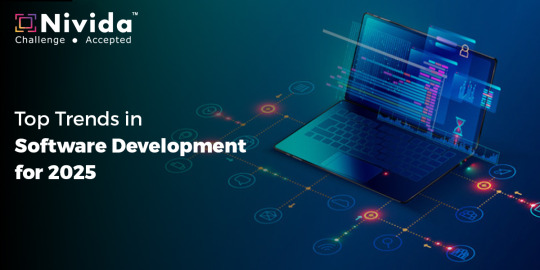
1. Artificial Intelligence and Machine Learning Integration:
Artificial Intelligence (AI) and Machine Learning (ML) are no longer optional but integral to modern software development. From predictive analytics to personalized user experiences, AI and ML are driving innovation across industries. In 2025, expect AI-powered tools to streamline development processes, improve testing, and enhance decision-making.
Businesses in Gujarat and beyond are leveraging AI to gain a competitive edge. Collaborating with the Best Software Development Company in Gujarat ensures access to AI-driven solutions tailored to specific industry needs.
2. Low-Code and No-Code Development Platforms:
The demand for faster development cycles has led to the rise of low-code and no-code platforms. These platforms empower non-technical users to create applications through intuitive drag-and-drop interfaces, significantly reducing development time and cost.
For startups and SMEs in Vadodara, partnering with the Best Software Development Company in Vadodara ensures access to these platforms, enabling rapid deployment of business applications without compromising quality.
3. Cloud-Native Development:
Cloud-native technologies, including Kubernetes and microservices, are becoming the backbone of modern applications. By 2025, cloud-native development will dominate, offering scalability, resilience, and faster time-to-market.
The Best Software Development Company in India can help businesses transition to cloud-native architectures, ensuring their applications are future-ready and capable of handling evolving market demands.
4. Edge Computing:
As IoT devices proliferate, edge computing is emerging as a critical trend. Processing data closer to its source reduces latency and enhances real-time decision-making. This trend is particularly significant for industries like healthcare, manufacturing, and retail.
Organizations seeking to leverage edge computing can benefit from the expertise of the Best Software Development Company in Gujarat, which specializes in creating applications optimized for edge environments.
5. Cybersecurity by Design:
With the increasing sophistication of cyber threats, integrating security into the development process has become non-negotiable. Cybersecurity by design ensures that applications are secure from the ground up, reducing vulnerabilities and protecting sensitive data.
The Best Software Development Company in Vadodara prioritizes cybersecurity, providing businesses with robust, secure software solutions that inspire trust among users.
6. Blockchain Beyond Cryptocurrencies:
Blockchain technology is expanding beyond cryptocurrencies into areas like supply chain management, identity verification, and smart contracts. In 2025, blockchain will play a pivotal role in creating transparent, tamper-proof systems.
Partnering with the Best Software Development Company in India enables businesses to harness blockchain technology for innovative applications that drive efficiency and trust.
7. Progressive Web Apps (PWAs):
Progressive Web Apps (PWAs) combine the best features of web and mobile applications, offering seamless experiences across devices. PWAs are cost-effective and provide offline capabilities, making them ideal for businesses targeting diverse audiences.
The Best Software Development Company in Gujarat can develop PWAs tailored to your business needs, ensuring enhanced user engagement and accessibility.
8. Internet of Things (IoT) Expansion:
IoT continues to transform industries by connecting devices and enabling smarter decision-making. From smart homes to industrial IoT, the possibilities are endless. In 2025, IoT solutions will become more sophisticated, integrating AI and edge computing for enhanced functionality.
For businesses in Vadodara and beyond, collaborating with the Best Software Development Company in Vadodara ensures access to innovative IoT solutions that drive growth and efficiency.
9. DevSecOps:
DevSecOps integrates security into the DevOps pipeline, ensuring that security is a shared responsibility throughout the development lifecycle. This approach reduces vulnerabilities and ensures compliance with industry standards.
The Best Software Development Company in India can help implement DevSecOps practices, ensuring that your applications are secure, scalable, and compliant.
10. Sustainability in Software Development:
Sustainability is becoming a priority in software development. Green coding practices, energy-efficient algorithms, and sustainable cloud solutions are gaining traction. By adopting these practices, businesses can reduce their carbon footprint and appeal to environmentally conscious consumers.
Working with the Best Software Development Company in Gujarat ensures access to sustainable software solutions that align with global trends.
11. 5G-Driven Applications:
The rollout of 5G networks is unlocking new possibilities for software development. Ultra-fast connectivity and low latency are enabling applications like augmented reality (AR), virtual reality (VR), and autonomous vehicles.
The Best Software Development Company in Vadodara is at the forefront of leveraging 5G technology to create innovative applications that redefine user experiences.
12. Hyperautomation:
Hyperautomation combines AI, ML, and robotic process automation (RPA) to automate complex business processes. By 2025, hyperautomation will become a key driver of efficiency and cost savings across industries.
Partnering with the Best Software Development Company in India ensures access to hyperautomation solutions that streamline operations and boost productivity.
13. Augmented Reality (AR) and Virtual Reality (VR):
AR and VR technologies are transforming industries like gaming, education, and healthcare. In 2025, these technologies will become more accessible, offering immersive experiences that enhance learning, entertainment, and training.
The Best Software Development Company in Gujarat can help businesses integrate AR and VR into their applications, creating unique and engaging user experiences.
Conclusion:
The software development industry is poised for significant transformation in 2025, driven by trends like AI, cloud-native development, edge computing, and hyperautomation. Staying ahead of these trends requires expertise, innovation, and a commitment to excellence.
For businesses in Vadodara, Gujarat, or anywhere in India, partnering with the Best Software Development Company in Vadodara, Gujarat, or India ensures access to cutting-edge solutions that drive growth and success. By embracing these trends, businesses can unlock new opportunities and remain competitive in an ever-evolving digital landscape.
#Best Software Development Company in Vadodara#Best Software Development Company in Gujarat#Best Software Development Company in India#nividasoftware
5 notes
·
View notes
Text
GIS In Our Daily Lives
The involvement of Geographic Information Systems (GIS) in our daily lives is pervasive, influencing and enhancing various aspects across different sectors. The integration of GIS into everyday activities has become integral for decision-making, planning, and optimizing resources. GIS helps city planners and transportation experts to provide them with information like maps, satellite pictures, population statistics, and infrastructure data. GIS helps them make better decisions when designing cities and transportation systems that are sustainable and good for the environment.
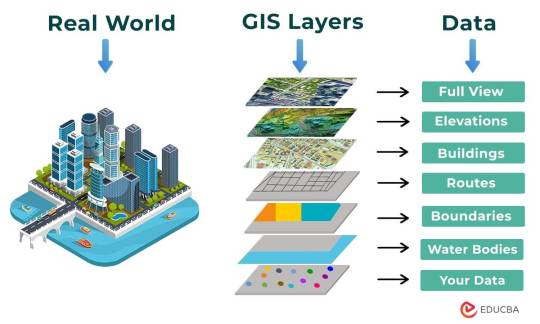
The following points elucidate the notable involvement of GIS in our daily lives:
Navigation and Location Services: GIS provides monitoring functions through the visual display of spatial data and precise geographical positioning of monitored vehicles, whereas GPS provides accurate, clear, and precise information on the position and navigation of a monitored or tracked vehicle in real-time and at the exact location.GIS is at the core of navigation applications and location-based services on smartphones. It enables accurate mapping, real-time navigation, and geolocation services, assisting individuals in finding locations, planning routes, and navigating unfamiliar areas.
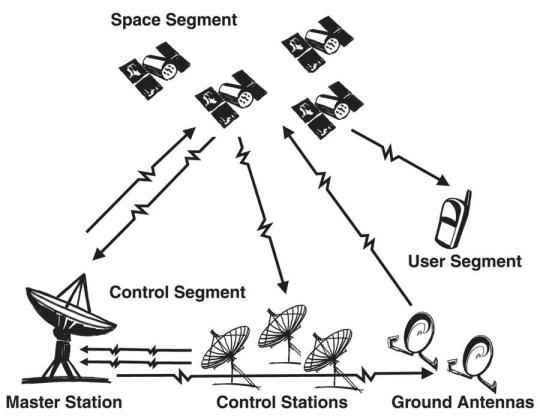
E-Commerce and Delivery Services: GIS software is a powerful tool for supply chain network planning. It helps determine the optimal location for distribution centers, warehouses, or other supply facilities. GIS is utilized in logistics and delivery services for optimizing routes, tracking shipments, and ensuring timely deliveries. E-commerce platforms leverage GIS to enhance the efficiency of their supply chain and last-mile delivery processes.
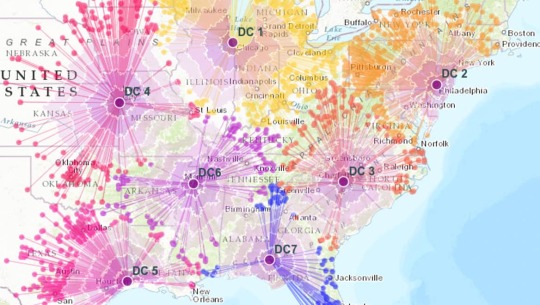
Weather Forecasting and Disaster Management: Many states are using GIS dashboard to monitor the rainfall across the state, on a real-time basis, from the data shared by rain sensors installed at various locationsGIS plays a crucial role in weather forecasting and disaster management. It assists meteorologists in analyzing spatial data, predicting weather patterns, and facilitating timely responses to natural disasters by mapping affected areas and coordinating emergency services.

Healthcare Planning and Disease Monitoring: Geographic Information Systems enable the visualization and monitoring of infectious diseases. Additionally GIS records and displays the necessary information that health care needs of the community as well as the available resources and materials. GIS supports public health initiatives by mapping the spread of diseases, analyzing healthcare resource distribution, and assisting in the planning of vaccination campaigns. It aids in identifying high-risk areas and optimizing healthcare service delivery.
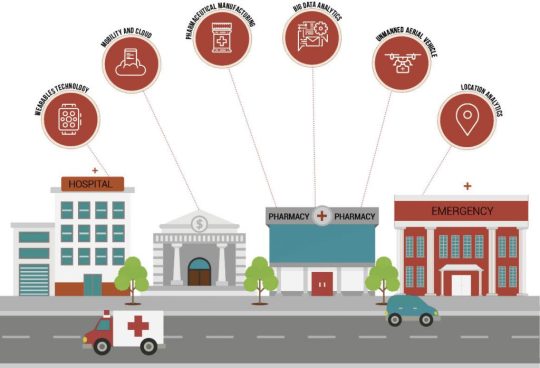
Social Media and Geo-tagging: GIS also helps in geotagging and other location related information in posts, it’s tools can map and visualize the spatial distribution of social media activity. This analysis can reveal trends, hotspots, and patterns in user engagement across different geographic areas. Many social media platforms incorporate GIS for geo-tagging, allowing users to share their location and experiences. This feature enhances social connectivity and facilitates the sharing of location-specific information.
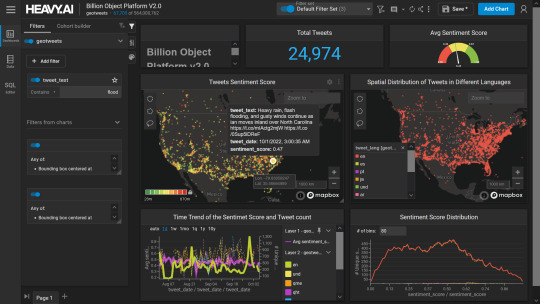
Smart City Initiatives: The Geographic Information System (GIS) offers advanced and user-friendly capabilities for Smart City projects and allows to capture, store and manipulate, analyze and visualize spatially referenced data. It is used for spatial analysis and modeling. It is the cornerstone of smart city planning, enabling the integration of data for efficient urban management. It supports initiatives related to traffic management, waste disposal, energy consumption, and overall infrastructure development.
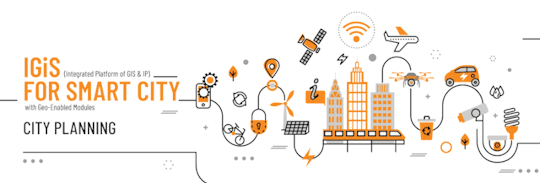
Education and Research: GIS is increasingly utilized in education and research for visualizing and analyzing spatial data. It enables students and researchers to explore geographic relationships, conduct field studies, and enhance their understanding of various subjects.

Agricultural Management and Precision Farming: Farmers leverage GIS to optimize agricultural practices by analyzing soil conditions, crop health, and weather patterns. Precision farming techniques, facilitated by GIS, contribute to increased crop yields and sustainable farming practices.

Real Estate and Property Management: In the real estate sector, GIS aids in property mapping, land valuation, and site selection. It provides real estate professionals with valuable insights into spatial relationships, market trends, and optimal development opportunities.
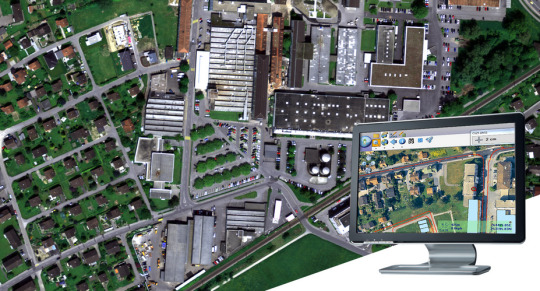
Tourism and Recreation: GIS enhances the tourism industry by providing interactive maps, route planning, and location-based information. It assists tourists in exploring destinations, finding attractions, and navigating efficiently.
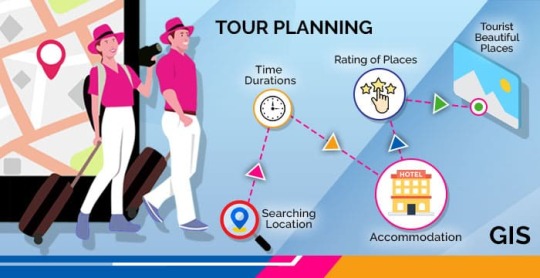
The broad and varied involvement of GIS in our daily lives underscores its significance as a technology that not only facilitates geographic data analysis but also contributes to the efficiency, safety, and interconnectedness of modern society. As GIS applications continue to evolve, their impact on daily activities is expected to further expand and refine.
#gis#architectdesign#architecture#city#education#geographic information system(gis)#geographical indication
13 notes
·
View notes
Text
The Future of AI & Humanity: A New Era of Possibilities?

The world is rapidly evolving with the rise of artificial intelligence (AI). From automating tasks to enhancing decision-making processes, AI is reshaping human life as we know it. But what does this mean for the future ? Will AI complement humanity or overshadow it ? Let’s see the importance of machine learning, AI for the future, and the profound impact of artificial intelligence.
A Collaborative Future for AI and Humanity
The journey of AI is no longer about competition between humans and machines. Instead, it’s about enhancing human potential through AI. By automating mundane tasks and enabling better decision-making, AI allows people to focus on what matters most—creativity, innovation, and problem-solving.
Machine learning lies at the heart of this transformation, with algorithms that improve through experience. The impact of AI will continue to grow, not just in industries like healthcare and education but also in daily life. Future artificial intelligence examples show that AI can unlock new ways to manage cities, provide personalised learning, and streamline supply chains.
Machine Learning: The Driving Force
When we talk about AI for the future, machine learning is essential. It is the key technology that allows computers to learn patterns, make predictions, and improve performance over time. For instance, virtual assistants powered by machine learning can anticipate user needs, while recommendation systems curate content based on individual preferences.
The beauty of machine learning is in its adaptability. From customer service chatbots to medical diagnostic tools, the impact of AI is seen everywhere. Businesses, startups, and even governments are practising AI & making machine learning more accessible to the public.
Future Artificial Intelligence Examples
We must updated with AI . It is important to stay updated with latest trends of AI by reading blogs & news related to AI. The influence of AI will only deepen with time, and here are some artificial intelligence examples that give us a glimpse into tomorrow & can make a bright future :
Healthcare: AI-driven diagnostic tools will predict diseases with higher accuracy.
Education: Personalized learning systems powered by machine learning will cater to each student’s pace and style.
Smart Cities: AI will optimise traffic flow, energy use, and waste management, making cities more efficient and sustainable.
These artificial intelligence examples demonstrate that AI will touch every facet of life, transforming the way people live and interact with technology.
The Challenges Ahead
While the potential of AI is immense, it comes with challenges. Issues like data privacy, algorithmic bias, and job displacement require immediate attention. The ethical impact of artificial intelligence cannot be ignored. Machine learning systems are only as good as the data they receive, meaning careful oversight is essential to prevent unintended biases.
We must develop regulations and frameworks that foster responsible AI innovation. Policymakers, developers, and users need to collaborate to create AI that works for humanity, not against it. The key is to ensure that AI for the future augments human capabilities rather than replaces them.
Building a Better Tomorrow
AI and humanity are not on opposite sides; they are partners in progress. With machine learning as the foundation, AI will unlock new opportunities that were previously unimaginable. The impact of artificial intelligence will enable humanity to solve global challenges—like climate change, healthcare access, and education inequities—faster and more efficiently than ever before.
What we do today will shape the next generation. If harnessed responsibly, AI for the future can create a world where technology amplifies human potential rather than diminishes it. This vision depends on a shared commitment to developing AI systems that reflect human values and ethics.
Conclusion
The fusion of AI and humanity is already underway. With machine learning driving innovations, AI for the future holds the power to transform industries, improve lives, and create a sustainable future. The impact of artificial intelligence will go beyond automation—it will redefine how we interact with technology and with each other.
The road ahead is full of both promise and challenges, but one thing is certain: AI and humanity are stronger together. Through thoughtful collaboration, we can ensure that AI for the future empowers people, enhances creativity, and builds a better world for generations to come.
#aionlinemoney.com
2 notes
·
View notes
Text
5 trend of ICT
The information and communications technology (ICT)
Artificial Intelligence (AI) and Machine Learning (ML)
AI and ML are at the forefront of ICT innovation, enabling machines to learn from data and perform tasks that traditionally required human intelligence. This includes tasks like image recognition, natural language processing, and predictive analytics. AI and ML are being used in a wide range of applications, from self-driving cars to personalized medicine to fraud detection.
Edge Computing
Edge computing is a distributed computing paradigm that brings computing and data storage closer to the source of data, such as smartphones, sensors, and IoT devices. This reduces latency and improves performance, making it ideal for real-time applications and data-intensive tasks. Edge computing is becoming increasingly important as the volume of data generated by IoT devices continues to grow.
cybersecurity
With the increasing reliance on technology, cybersecurity has become a critical concern. Cyberattacks are becoming more sophisticated and widespread, targeting individuals, businesses, and governments. The ICT industry is responding with advanced security solutions, including threat intelligence, intrusion detection systems, and data encryption.
Blockchain
Blockchain is a distributed ledger technology that enables secure and transparent transactions. It is being used to develop applications in various sectors, including finance, supply chain management, and healthcare. Blockchain technology has the potential to revolutionize how we interact with each other and with businesses.
Virtual Reality (VR) and Augmented Reality (AR)
VR and AR technologies are creating immersive experiences that blur the lines between the physical and digital worlds. VR immerses users in a simulated environment, while AR overlays digital information onto the real world. These technologies are being used in gaming, entertainment, education, and training.
In conclusion, these five trends are shaping the future of ICT, driving innovation and transforming how we live, work, and interact with the world. As these technologies continue to evolve, we can expect to see even more exciting developments
2 notes
·
View notes
Text
The Future of ERP Software in India: Trends to Watch in 2024
As India continues to solidify its position as a global economic powerhouse, the demand for sophisticated Enterprise Resource Planning (ERP) solutions has never been higher. ERP software companies in India are at the forefront of this transformation, driving innovation and efficiency across various industries. As we look ahead to 2024, several key trends are shaping the future of ERP software in India. This blog delves into these trends, offering insights into how ERP software providers in India are gearing up to meet the evolving needs of businesses.
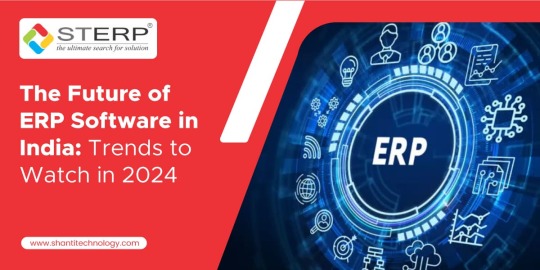
1. Increased Adoption of Cloud-Based ERP Solutions
One of the most significant trends in the ERP landscape is the shift towards cloud-based solutions. ERP software companies in India are increasingly offering cloud-based ERP systems to meet the growing demand for flexibility, scalability, and cost-efficiency. Cloud ERP solutions eliminate the need for extensive on-premises infrastructure, allowing businesses to reduce capital expenditure and streamline operations.
Cloud-based ERP systems also facilitate real-time data access and collaboration, enabling businesses to make informed decisions quickly. This trend is particularly beneficial for small and medium-sized enterprises (SMEs) that require affordable and scalable ERP solutions to compete effectively in the market.
2. Integration of Artificial Intelligence and Machine Learning
Artificial Intelligence (AI) and Machine Learning (ML) are revolutionizing the ERP landscape. ERP software providers in India are integrating AI and ML technologies to enhance the capabilities of their solutions. These technologies enable predictive analytics, automate routine tasks, and provide intelligent insights, helping businesses to optimize their operations.
For instance, AI-powered ERP systems can forecast demand, manage inventory levels, and predict maintenance needs, significantly improving efficiency and reducing costs. As AI and ML technologies continue to evolve, their integration into ERP systems will become more sophisticated, offering even greater value to businesses.
3. Focus on Industry-Specific ERP Solutions
ERP software companies in India are increasingly developing industry-specific ERP solutions to cater to the unique needs of different sectors. Whether it is manufacturing, retail, healthcare, or finance, each industry has distinct requirements that generic ERP systems might not fully address. Industry-specific ERP solutions offer tailored functionalities and workflows, ensuring better alignment with business processes.
For example, a manufacturing ERP system might include features for production planning, quality control, and supply chain management, while a retail ERP system could focus on inventory management, point of sale (POS) integration, and customer relationship management (CRM). This trend towards specialization ensures that businesses can leverage ERP systems that truly support their operational needs.
4. Enhanced Mobile Accessibility
With the proliferation of smartphones and mobile devices, the need for mobile-friendly ERP solutions is growing. ERP software providers in India are developing mobile applications that allow users to access critical business information on the go. Mobile ERP solutions enable employees to perform tasks such as inventory checks, sales order processing, and expense reporting from their smartphones or tablets.
This trend not only improves accessibility but also enhances productivity by enabling employees to work remotely and make decisions in real-time. As mobile technology continues to advance, the functionality and user experience of mobile ERP applications will improve, making them an indispensable tool for modern businesses.
5. Increased Emphasis on Data Security and Compliance
As businesses become more reliant on digital technologies, data security and compliance have become paramount. ERP software providers in India are prioritizing data protection by incorporating advanced security features into their solutions. This includes encryption, multi-factor authentication, and regular security audits to safeguard sensitive business information.
Moreover, with the implementation of regulations such as the General Data Protection Regulation (GDPR) and India’s Personal Data Protection Bill, compliance is a critical concern for businesses. ERP software providers are ensuring that their systems comply with these regulations, helping businesses avoid legal penalties and build trust with their customers.
6. Rise of Hybrid ERP Solutions
While cloud-based ERP systems offer numerous advantages, some businesses prefer on-premises solutions due to specific regulatory or operational requirements. To cater to these diverse needs, ERP software companies in India are offering hybrid ERP solutions that combine the benefits of both cloud and on-premises systems.
Hybrid ERP solutions provide the flexibility of cloud-based systems while allowing businesses to maintain critical applications on-premises. This approach offers a balanced solution, enabling businesses to optimize their IT infrastructure based on their unique needs and preferences.
7. Adoption of Advanced Analytics and Business Intelligence
Data is the new currency in today’s business environment, and the ability to harness and analyze data is a key competitive advantage. ERP software providers in India are integrating advanced analytics and business intelligence (BI) tools into their systems. These tools enable businesses to gain deep insights into their operations, identify trends, and make data-driven decisions.
Advanced analytics and BI tools can analyze large volumes of data from various sources, providing comprehensive reports and dashboards. This helps businesses to monitor performance, identify inefficiencies, and uncover new opportunities for growth.
8. Greater Focus on User Experience and Interface Design
The user experience (UX) and interface design of ERP systems are critical to their adoption and effectiveness. ERP software companies in India are placing a greater emphasis on developing intuitive and user-friendly interfaces. This trend is driven by the need to ensure that ERP systems are accessible and easy to use for all employees, regardless of their technical expertise.
Modern ERP systems feature clean, responsive interfaces with customizable dashboards and navigation options. This focus on UX design helps to improve user satisfaction, reduce training time, and increase overall productivity.
9. Integration with the Internet of Things (IoT)
The Internet of Things (IoT) is transforming the way businesses operate by enabling real-time monitoring and data collection from connected devices. ERP software providers in India are integrating IoT capabilities into their systems to enhance operational efficiency and decision-making.
IoT-enabled ERP systems can monitor equipment performance, track inventory levels, and optimize supply chain operations. For example, sensors placed on manufacturing equipment can detect anomalies and trigger maintenance requests before a breakdown occurs. This integration of IoT with ERP systems allows businesses to leverage real-time data for proactive management and improved efficiency.
10. Sustainable and Green ERP Solutions
Sustainability is becoming a key consideration for businesses across industries. ERP software companies in India are developing solutions that support sustainable practices and environmental responsibility. Green ERP solutions help businesses to monitor and reduce their environmental impact by tracking energy consumption, waste management, and resource utilization.
By integrating sustainability metrics into their ERP systems, businesses can set and achieve environmental goals, comply with regulations, and enhance their corporate social responsibility (CSR) initiatives. This trend towards sustainable ERP solutions reflects the growing importance of environmental stewardship in today’s business landscape.
Conclusion
The future of ERP software in India is marked by innovation, adaptability, and a deep understanding of the unique needs of businesses. ERP software providers in India are leading the charge, offering solutions that are not only technologically advanced but also aligned with the evolving demands of the market. As we move into 2024, the trends highlighted in this blog will play a crucial role in shaping the ERP landscape, driving efficiency, and fostering growth across industries.
ERP software providers in India are well-positioned to support businesses in their digital transformation journeys, providing the tools and insights needed to thrive in a competitive environment. By staying ahead of these trends, businesses can leverage ERP solutions to achieve operational excellence and sustainable growth.
#ERP software Companies in India#ERP software providers in India#ERP software company in India#ERP software in India#ERP solution provider#ERP software#ERP system#cloud ERP#ERP solutions
4 notes
·
View notes
Text
Transforming the Health Landscape: The Global Blockchain in Healthcare Market
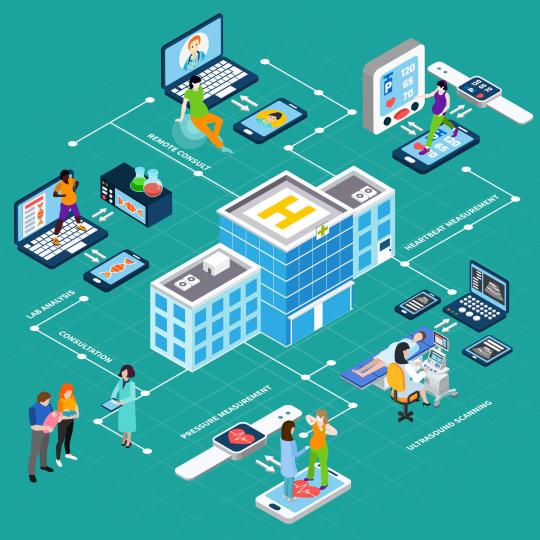
The integration of blockchain technology into the healthcare sector is revolutionizing the way medical data is managed, shared, and secured. As the demand for transparent, efficient, and secure healthcare services grows, blockchain offers promising solutions to longstanding challenges.
Understanding Blockchain in Healthcare
Blockchain Technology is a decentralized digital ledger that records transactions across multiple computers in a way that ensures the security and transparency of data. In healthcare, blockchain can be used to manage patient records, track pharmaceuticals, ensure the integrity of clinical trials, and streamline administrative processes. The immutable nature of blockchain helps in preventing data breaches, ensuring data accuracy, and enhancing patient privacy.
According to BIS Research, the Global Blockchain in Healthcare Market was estimated to grow to a value of $5.61 billion by 2025, and still the market is showing a steep growth till 2030 witnessing a double-digit CAGR growth rate throughout the forecast period.
Key Market Dynamics
Several factors are driving the growth of the global blockchain in healthcare market:
Data Security and Privacy:
Need for robust data security and privacy solutions.
Healthcare data breaches are a growing concern.
Blockchain's secure, immutable nature protects sensitive patient information.
Interoperability and Data Sharing:
Facilitates seamless data sharing between healthcare providers and systems.
Overcomes current interoperability issues.
Leads to better patient outcomes by providing a comprehensive view of health history.
Supply Chain Transparency:
Tracks the entire lifecycle of drugs in the pharmaceutical industry.
Ensures the authenticity of medications.
Helps combat counterfeit drugs.
Efficient Administrative Processes:
Streamlines various administrative processes, such as billing and claims management.
Reduces fraud and administrative costs.
Support from Regulatory Bodies:
Increasing support from regulatory bodies and governments.
Initiatives by FDA and EMA to explore blockchain for drug traceability and clinical trials boost market growth.
Request for an updated Research Report on Global Blockchain in Healthcare Market Research.
Global Blockchain in Healthcare Industry Segmentation
Segmentation by Application:
Data Exchange and Interoperability
Supply Chain Management
Claims Adjudication and Billing Management
Clinical Trials and Research
Others
Segmentation by End-User:
Healthcare Providers
Pharmaceutical Companies
Payers
Others
Segmentation by Region:
North America
Europe
Asia-Pacific
Latin America and Middle East & Africa
Future Market Prospects
The future of the global blockchain in healthcare market looks promising, with several trends likely to shape its trajectory:
Integration with AI and IoT: The integration of blockchain with artificial intelligence (AI) and the Internet of Things (IoT) will enhance data analytics, predictive healthcare, and real-time monitoring.
Expansion of Use Cases: New use cases for blockchain in digital healthcare will emerge, including patient-centered care models, personalized medicine, and enhanced telemedicine services.
Focus on Patient-Centric Solutions: Blockchain will enable more patient-centric healthcare solutions, empowering patients with greater control over their health data and enhancing patient engagement.
Development of Regulatory Frameworks: The establishment of clear regulatory frameworks and industry standards will facilitate the widespread adoption of blockchain in healthcare.
Conclusion
The Global Blockchain in Healthcare Industry is poised for significant growth, driven by the need for enhanced data security, interoperability, supply chain transparency, and efficient administrative processes. By addressing challenges related to regulatory compliance, implementation costs, standardization, and scalability, and leveraging opportunities in technological advancements, investments, partnerships, and government initiatives, the potential of blockchain in healthcare can be fully realized. This technology promises to revolutionize healthcare delivery, enhancing efficiency, transparency, and patient outcomes, and setting new standards for the future of digital health.
#Blockchain in Healthcare Market#Blockchain in Healthcare Industry#Blockchain in Healthcare Market Report#Blockchain in Healthcare Market Research#Blockchain in Healthcare Market Forecast#Blockchain in Healthcare Market Analysis#Blockchain in Healthcare Market Growth#BIS Research#Healthcare
2 notes
·
View notes
Text
Elevating Your Expertise: The Must-Attend Monthly Virtual Event for AI, Blockchain, and Marketing Enthusiasts
1. A Deep Dive into Artificial Intelligence (AI):
AI is transforming industries, from healthcare to education or finance. At 'The Art of Elevation,' leading experts demystify AI, covering its latest advancements and applications. You'll gain insights into machine learning algorithms, data analytics, and how AI is shaping decision-making processes. This event provides a unique platform to understand AI's ethical implications and future potential, empowering you to leverage AI for more innovative, more efficient business solutions.
2. Unlocking the Potential of Blockchain:
Blockchain goes beyond just powering cryptocurrencies. It's a revolutionary technology that ensures transparency, security, and decentralization. This event delves into the practical uses of blockchain in various sectors, including supply chain management, voting systems, and digital identity verification. Understanding blockchain through this event can be a game-changer, offering you a competitive edge in harnessing this technology for business innovation and trust-building.
3. Cutting-Edge Marketing Strategies:
Marketing is ever-evolving in the digital age. 'The Art of Elevation' illuminates the latest marketing strategies, digital trends, and consumer behavior analytics. Learn how to enhance brand visibility and engagement through social media, SEO, content marketing, and digital advertising. This segment is crucial for those looking to adapt and thrive in the dynamic digital landscape.
4. Networking with Like-Minded Professionals:
Networking is vital in the professional world. This event is a melting pot of experts, entrepreneurs, and enthusiasts, offering a rich collaboration and idea exchange environment. Building connections here could lead to future partnerships, mentorships, or career advancements.
5. Addressing Loopholes for Career Advancement:
Understanding the pitfalls and challenges in AI, blockchain, and marketing is vital for career growth. This event highlights these areas and provides actionable strategies for overcoming them. Attendees will finally equipped with the knowledge to sidestep common pitfalls and navigate their career paths more effectively.
6. Free and Accessible Learning:
The fact that this event is free makes it an invaluable resource. Accessibility to such high-caliber knowledge and networking opportunities without any cost barrier is rare and should be capitalized upon by anyone looking to grow in these fields.
In conclusion, 'The Art of Elevation' is more than just an event; it's a monthly opportunity to stay updated, network, and grow in AI, blockchain, and marketing. Attending this event could catalyze your next giant career leap, whether a seasoned professional or starting.
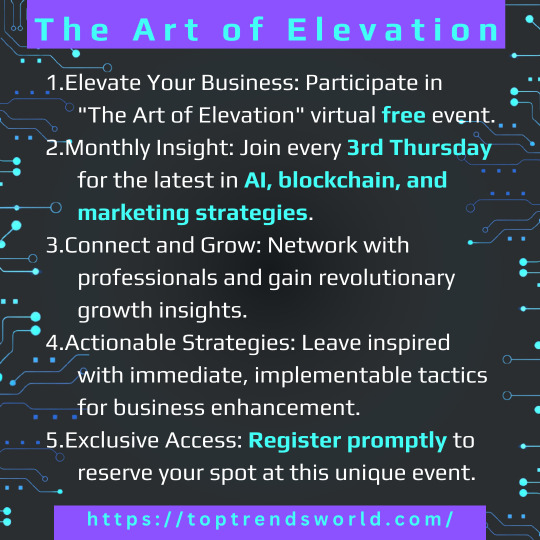
3 notes
·
View notes
Text
Empowering Decision-Making: Unlocking the Potential of Data Science Across Industries
In the era of information abundance, data has become a formidable asset. However, the real distinction for successful enterprises lies in their ability to derive meaningful insights from this vast sea of data. Enter data science – a field that transcends mere analysis and offers a transformative lens through which industries can innovate, optimize, and thrive. Opting for the Best Data Science Institute can further expedite your journey into this burgeoning industry. In this blog, we will delve into the diverse applications of data science across various sectors, spotlighting its pivotal role in steering informed decision-making and fostering innovation.
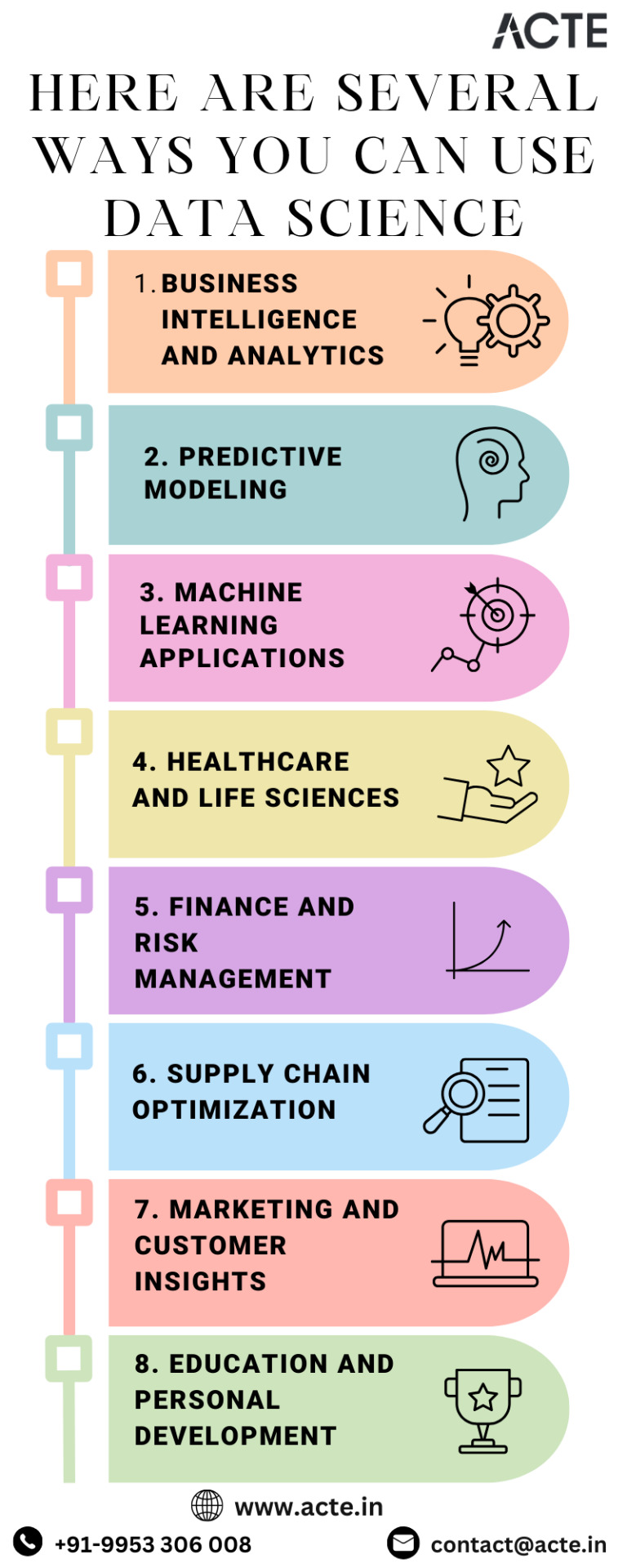
1. Business Intelligence and Analytics: Revealing Patterns for Growth
At the heart of data science is the ability to unravel intricate patterns within extensive datasets. For businesses, this translates into a powerful tool for business intelligence and analytics. By harnessing historical and current data, organizations can gain valuable insights into their performance, identify trends, and make informed decisions that drive growth. Whether optimizing operational processes or uncovering opportunities for expansion, data science serves as a compass for strategic decision-making.
2. Predictive Modeling: Forecasting the Future with Confidence
Predictive modeling stands out as one of the hallmark applications of data science. By analyzing historical data, organizations can develop models that forecast future trends and outcomes. This capability proves invaluable across various domains. In finance, predictive modeling aids in anticipating stock prices; in healthcare, it contributes to predicting patient outcomes. The ability to foresee potential scenarios empowers decision-makers to plan and strategize with confidence.
3. Machine Learning Applications: Infusing Intelligence into Applications
Machine learning, a subset of data science, takes analytical power a step further by enabling intelligent applications. From recommendation systems in e-commerce to fraud detection in finance and image recognition in healthcare, machine learning algorithms bring a layer of automation and adaptability to diverse domains. This not only enhances user experience but also improves the efficiency and effectiveness of various processes.
4. Healthcare and Life Sciences: Revolutionizing Patient Care and Research
In the realm of healthcare, data science acts as a catalyst for transformation. From patient diagnosis to personalized treatment plans and drug discovery, data-driven insights are revolutionizing the industry. Analyzing large datasets allows medical professionals to identify patterns, tailor treatment strategies, and accelerate medical research, ultimately leading to better patient outcomes.
5. Finance and Risk Management: Navigating Uncertainty with Data-Driven Insights
Financial institutions leverage the power of data science for risk assessment, fraud detection, and portfolio optimization. Predictive analytics aids in forecasting market trends, managing risks, and making informed investment decisions. In an industry where every decision carries significant consequences, data science provides a reliable compass for navigating uncertainties. Choosing the finest Data Science Courses in Chennai is a pivotal step in acquiring the necessary expertise for a successful career in the evolving landscape of data science.
6. Supply Chain Optimization: Enhancing Efficiency from End to End
Optimizing supply chain operations is a complex endeavor, but data science offers a clear path forward. By utilizing data to forecast demand, manage inventory effectively, and optimize logistics, organizations can achieve substantial cost savings and improve overall operational efficiency. From manufacturers to retailers, data science is reshaping how businesses approach the end-to-end supply chain process.
7. Marketing and Customer Insights: Tailoring Strategies for Success
In the realm of marketing, data science emerges as a game-changer. Analyzing customer behavior, preferences, and engagement patterns allows marketers to create targeted campaigns that resonate with their audience. The ability to derive actionable insights from data enhances customer experience, improves satisfaction, and maximizes the impact of marketing initiatives.
8. Social Media Analysis: Decoding Trends and Sentiments
The digital era has ushered in an abundance of social media data, and data science plays a crucial role in making sense of this vast landscape. By analyzing social media data, businesses can extract valuable insights into user behavior, sentiment, and trends. This information is instrumental in shaping social media strategies, engaging with the audience effectively, and managing online reputation.
9. Smart Cities and Urban Planning: Paving the Way for Sustainable Living
In the context of urban planning, data science contributes to the development of smart cities. By analyzing data from sensors, traffic cameras, and citizen feedback, urban planners can optimize city infrastructure, improve traffic flow, and enhance overall urban living. Data-driven insights play a pivotal role in creating sustainable and livable urban environments.
10. Education and Personal Development: Shaping the Future of Learning
Data science is making significant inroads into education, where it is utilized to analyze student performance, tailor learning materials, and provide personalized recommendations. This not only enhances the learning experience for students but also facilitates adaptive learning platforms. The application of data science in education is reshaping how we approach teaching and learning, with a focus on individualized and effective educational experiences.

As we delve deeper into the era of big data, data science stands as a beacon of innovation and progress. Its applications span across industries, touching every facet of modern life. From healthcare and finance to education and urban planning, data science is shaping the way we make decisions, solve problems, and envision the future. Embracing the power of data science is not just a choice; it's a necessity for those looking to thrive in a data-driven world.
3 notes
·
View notes
Text
The Tech Odyssey:Navigating the Digital Age
In an era where technology is at the forefront of our lives, it's almost impossible to imagine a world without its profound influence. From the gadgets we carry in our pockets to the complex systems that power industries, technology is the driving force behind innovation and progress. In this blog, we'll dive into the ever-evolving world of technology, exploring its impact, trends, and the possibilities it holds for the future.
The Digital Revolution
The digital revolution has transformed the way we live, work, and communicate. It has brought us closer together while simultaneously creating a complex web of opportunities and challenges. Here are some key aspects to consider:
Connectivity: The rise of the internet and mobile technology has connected people and information like never before, reshaping industries from education to healthcare.
Artificial Intelligence: AI is changing the way we approach problems, from self-driving cars to virtual personal assistants like Siri and Alexa.
Data & Privacy: With great connectivity comes great responsibility. The debate on data privacy and security is more critical than ever, as we grapple with balancing convenience and personal information protection.
2. Emerging Technologies
The tech world is in a constant state of innovation. Some of the most exciting emerging technologies include:
Blockchain: Beyond cryptocurrencies like Bitcoin,blockchain technology holds potential for secure and transparent transactions, supply chain management, and more.
Quantum Computing: Quantum computers have the potential to revolutionize computing by solving complex problems faster than classical computers ever could.
Augmented & Virtual Reality ( AR / VR ): AR and VR are changing the way we experience entertainment, education, and even remote work.
3. Tech Trends
Keeping up with the latest tech trends can be both exciting and overwhelming. Some trends worth noting include:
5G Connectivity: The rollout of 5G networks promises faster internet speeds, enabling technologies like IoT (Internet of Things) to thrive.
Edge Computing: With more devices connected to the internet, edge computing brings processing closer to the data source, reducing latency and improving efficiency.
Sustainability: As we face environmental challenges, technology plays a crucial role in finding sustainable solutions, from renewable energy to green tech innovations.
4. Tech In Our Daily Lives
Technology has infiltrated every aspect of our daily lives, from how we communicate with loved ones to how we entertain ourselves. Consider:
Smart Homes: The integration of technology into our homes allows for greater convenience, energy efficiency, and security.
Health Tech: Wearable devices and health apps empower individuals to take control of their health and wellness.
E - commerce: Online shopping has transformed the retail landscape, offering convenience and an ever-expanding array of products.
5. The Future Of Tech
The future of technology is a thrilling frontier filled with possibilities. Some predictions include:
Autonomous Vehicles: Self-driving cars may become a common sight on the roads, changing transportation and urban planning.
Space Exploration: Private companies are driving the commercialization of space travel, making it accessible to more people.
Biotechnology: Advances in biotech could revolutionize medicine, offering personalized treatments and possibly even extending human lifespans.
Technology is not just a tool; it's a dynamic force shaping our world. Embracing its potential while addressing its challenges is our collective responsibility. As we embark on this tech odyssey, let's keep in mind the importance of ethics, security, and sustainability to ensure that technology continues to be a force for good, enhancing our lives and pushing the boundaries of what's possible in the digital age. Stay tuned as we explore the ever-evolving landscape of technology and its profound impact on our future.
#TECHWANDERER
3 notes
·
View notes